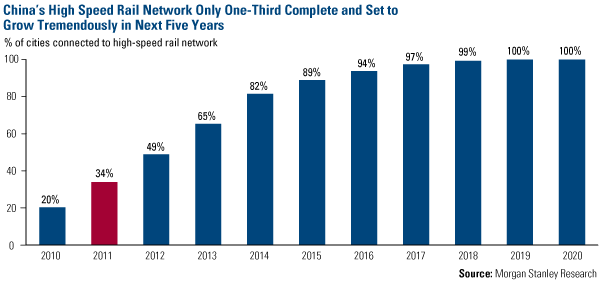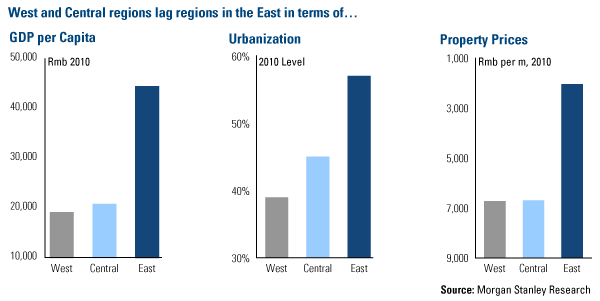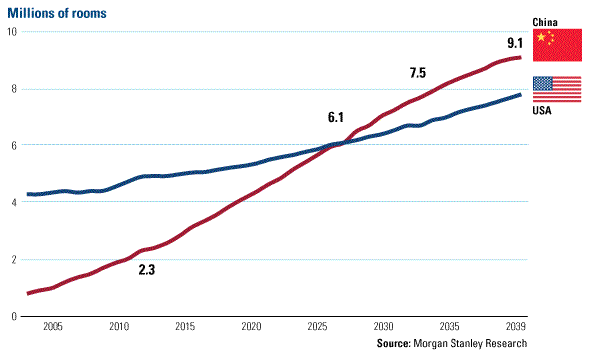Railway Revolution Builds China’s Consumer Culture
Economics / China Economy Jun 04, 2011 - 11:51 AM GMTBy: Frank_Holmes
 Frequent readers of my “Frank Talk” blog and the weekly Investor Alert should be familiar with the story of China’s high speed rails. We’ve previously discussed how China is building the world’s largest network of high speed rails at an incredible speed.
Frequent readers of my “Frank Talk” blog and the weekly Investor Alert should be familiar with the story of China’s high speed rails. We’ve previously discussed how China is building the world’s largest network of high speed rails at an incredible speed.
Since opening the first high speed line between Beijing and Tianjin in 2008, the country has laid down more than 4,600 miles of new tracks. This is three times more than Japan, where the bullet train was invented, and this is just the start. Once completed near the end of this decade, the high speed rail system will connect more than 250 Chinese cities, span 18,641 miles and reach roughly 700 million people.
Currently, the high speed rail network connects about one-third of China’s cities. That figure is set to nearly double over the next two years. If current forecasts hold true, 100 percent of the China’s cities will be connected through high speed rails by 2019.

While linking megacities such as Beijing and Shanghai carries significance, connecting the urban East with rural areas of West and Central China is equally as important. This data from Morgan Stanley shows that the West and Central regions of China lag considerably in terms of GDP per capita, urbanization rate and property prices.

Many, including our investment team, believe that connecting these areas of the country could have a similar effect to what took place in the United States when Eisenhower’s interstate highway system linked cities such as Chicago and Philadelphia with their counterparts on the West Coast including Seattle and San Francisco.
The effect this massive buildout can have on commodities is evident: thousands of miles of new track, hundreds of new stations and dozens of new trains will certainly boost demand for steel. But there’s also a corollary effect that can expedite the transformation of China’s economy. More people traveling across the country means there will need to be more places for them to eat, sleep and shop.
Take hotel rooms for example. Currently, the U.S. has just fewer than 5 million hotel rooms spread across the country; China has about half that amount. However, Morgan Stanley forecasts that the two are set to switch places near 2025 as China pushes to offer more than 9 million hotel rooms by 2039. Familiar names such as Wyndham, Starwood and Hilton are planning major additions to their pipelines in China.

Morgan Stanley also says that the high speed rail expansion presents opportunities in areas such as consumer staples, car rentals and tourism. The latter is especially important because the average Chinese citizen is going to be able to explore culturally rich areas of the country that were previously too difficult or expensive to visit. A poll from CLSA’s China Reality Research last year showed that travel remained a top aspiration.
Rail passenger traffic has a strong correlation with instant noodle consumption (79 percent positive correlation) and soft drink volume (86 positive correlation), according to Morgan Stanley. This means that chains such as McDonald’s (1,300 stores in China) and KFC (4,000 stores in China), both of which are largely concentrated in the eastern third of the country, will likely follow the high speed tracks into Central and Western China.
These are all examples of how the dynamics of the Chinese consumer are forever changing. As investors, it’s important to understand these intermarket relationships and how a development in one area of an economy can dramatically affect another seemingly unrelated area of the economy. Being able to spot these trends and developments before they bubble up to the surface is how active money managers can create alpha for their shareholders.
Want to receive commentary from Frank and analysis from the rest of the U.S. Global Investors team delivered to your inbox every Friday? Sign up to receive our weekly Investor Alert at www.usfunds.com.
For more updates on global investing from Frank and the rest of the U.S. Global Investors team, follow us on Twitter at www.twitter.com/USFunds or like us on Facebook at www.facebook.com/USFunds. You can also watch exclusive videos on what our research overseas has turned up on our YouTube channel at www.youtube.com/USFunds.
Please consider carefully the fund's investment objectives, risks, charges and expenses. For this and other important information, obtain a fund prospectus by visiting www.usfunds.com or by calling 1-800-US-FUNDS (1-800-873-8637). Read it carefully before investing. Distributed by U.S. Global Brokerage, Inc.
Standard deviation is a measure of the dispersion of a set of data from its mean. The more spread apart the data, the higher the deviation. Standard deviation is also known as historical volatility. All opinions expressed and data provided are subject to change without notice. Some of these opinions may not be appropriate to every investor. The S&P 500 Stock Index is a widely recognized capitalization-weighted index of 500 common stock prices in U.S. companies. The NYSE Arca Gold BUGS (Basket of Unhedged Gold Stocks) Index (HUI) is a modified equal dollar weighted index of companies involved in gold mining. The HUI Index was designed to provide significant exposure to near term movements in gold prices by including companies that do not hedge their gold production beyond 1.5 years. The MSCI Emerging Markets Index is a free float-adjusted market capitalization index that is designed to measure equity market performance in the global emerging markets. The U.S. Trade Weighted Dollar Index provides a general indication of the international value of the U.S. dollar.
Frank Holmes Archive |
© 2005-2022 http://www.MarketOracle.co.uk - The Market Oracle is a FREE Daily Financial Markets Analysis & Forecasting online publication.



